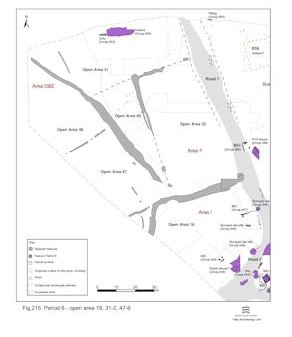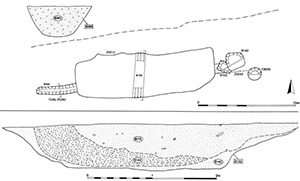
To the west of Road 1, the nature of the ?former Northern Zone is far from clear (Figure 215). While the last vestiges of the road may be judged to continue to provide an eastern boundary, and ditch 25027 to persist along its south, it is unlikely that its interior retains any significant subdivisions. Ditch 25021, so long a principal boundary, contains no latest Roman material and must be assumed to pass out of use prior to the late 4th century.
All occupying Period 6 features are ostensibly Late Roman, although some may simply lack the diagnostic few sherds of pottery that indicate an Early Saxon date.

Shallow linear feature 25240 (segs 8066, 8088), runs on an east-west alignment within Excavation Area E, along the northern edge of Development Area A1. Traced for a distance of 4.4m, it is 0.75m wide and 0.25m deep with a rounded terminal at its west end. Dated to the late 4th century or later, its single fill includes abraded pottery, much of which is residual, along with a 1st-century AD brooch. Its eastward extent is truncated by pit/ditch 25212.

Pit/ditch 25212 (seg. 8152) is a long, broad, feature with parallel sides and rounded ends (Figure 225). At c. 15m long and 4.5m wide, it is by far the largest single feature of any period in this part of the settlement (Excavation Area E). It is clearly aligned and located in relation to underlying lesser gully/ditch 25240, for which it appears to be a direct replacement. Its moderately sloping sides extend to a flat base at a depth of c. 0.7m (reaching to 2.05m OD). Its eastern extent stops just short of pits 8142 and 8155 (Group 836 Period 5), which may be significant and could even suggest that these seemingly late 3rd to early 4th-century AD pits are still open or visible, or else are in fact contemporary with it (8142 contained a sherd of, probably intrusive, Saxon pottery).
The fills of 25212 show signs of partial cleaning out or re-cutting. It is finally infilled with a single substantial dark silt deposit (8076) that includes large quantities of tile, pottery and animal bone, dating to the later 4th century AD+. The presence of worked antler supports a late, possibly Early Saxon, date for this episode. There is also a large residual element in the finds assemblage and it appears that this large cut must disturb significant earlier features, as would be expected.
25212 is reminiscent of Period 3 'big pit' 25221, which is of similar proportion and overlies/replaces a much slighter boundary ditch. Some further morphological comparison can perhaps be made with ditch 177 at Slough House Farm (Wallis and Waughman 1998, 34), which is very similar in both plan and section, but was, however, thought to be Late Iron Age.
Although no specifically Period 6 pits seem to occur within the Northern Zone, a number of earlier features, such as Period 5 pit 10504 (Group 989) continue to accumulate latest Roman material in slump hollows within their tops.
Internet Archaeology is an open access journal based in the Department of Archaeology, University of York. Except where otherwise noted, content from this work may be used under the terms of the Creative Commons Attribution 3.0 (CC BY) Unported licence, which permits unrestricted use, distribution, and reproduction in any medium, provided that attribution to the author(s), the title of the work, the Internet Archaeology journal and the relevant URL/DOI are given.
Terms and Conditions | Legal Statements | Privacy Policy | Cookies Policy | Citing Internet Archaeology
Internet Archaeology content is preserved for the long term with the Archaeology Data Service. Help sustain and support open access publication by donating to our Open Access Archaeology Fund.